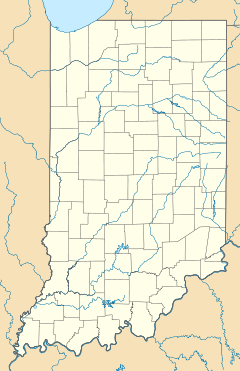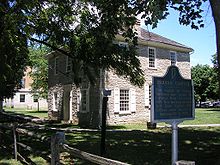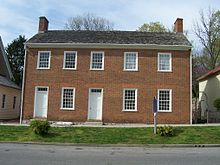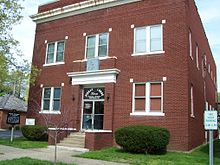- Corydon Historic District
-
Corydon Historic District
 Old State Capitol
Old State CapitolLocation: Not specified (original); Roughly bounded by Summit, Maple & Walnut Sts., College Ave., Chestnut, Capitol, Poplar, Water, Beaver & Mulberry Sts. (increase), Corydon, Indiana Coordinates: 38°12′42″N 86°7′26″W / 38.21167°N 86.12389°WCoordinates: 38°12′42″N 86°7′26″W / 38.21167°N 86.12389°W Built: 1813 Architect: George L. Mesker & Co.; William Mitchell (increase) Architectural style: Federal Governing body: Local NRHP Reference#: 73000017 and 89000243[1] Added to NRHP: August 28, 1973 (original)
June 27, 1989 (increase)The Corydon Historic District of Corydon, Indiana, United States, is listed on the National Register of Historic Places. It is also known as Indiana's First State Capital and as Historic Corydon. In 1973, the district comprised the old statehouse and the square around, and in 1989, it was extended so that it extends to Indian Creek in the north and west, College Avenue in the east, and Little Indian Creek to the south. Eight buildings within the district were standing when Corydon was the capital of Indiana.
Contents
Sites
The centerpiece of the district is a two-story Federal-style limestone building that was once the capitol of Indiana from 1816-1825, and is now the Corydon Capital State Historic Site. It was originally intended to double as the county courthouse; the county would occasionally use the capitol when the state government was not in session.
Next to the old capitol is the Harrison County Courthouse. Between the two buildings, historical markers denote John Hunt Morgan's capture of the town in July 1863. It sees 30,000 visitors every year.[2] Protected by a sandstone memorial is the Constitution Elm. In 1816 the trunk was five feet across, with branches spreading out 132 feet (40 m). Due to the heat of the capitol building, much of the deliberations for creating the Indiana state government and the writing of the constitution was under its branches. Dutch elm disease destroyed the tree in 1925, leaving only the trunk. The First State Office Building is located directly east of the Governor's Headquarters on Walnut Street. The Historic Sites administration in Indianapolis has delayed the renovation of this building for over ten years.
On May 22, 2007, plans were announced to build a memorial to late Indiana Governor Frank O'Bannon on the southwest corner of the courthouse square, which is 20 feet (6.1 m) by 20 feet (6.1 m) and have a life-sized likeness of O'Bannon in bronze on a limestone bench, with three pillars honoring O'Bannon, his father, and his grandfather, all of whom were prominent in Corydon. The memorial cost $200,000 and was unveiled in June 2008.[3] Officials in Indianapolis now plan to replace much of the town square with a concrete walkway complete with interpretive markers.
The Kintner House Hotel is within the district, but is listed separately on the National Register. The Leora Brown School is located on Summit Street and is the oldest standing African-American school in Indiana. The Kintner-McGrain House, also called Cedar Glade, is located on the north side of the district on the bank of the Indian Creek. Behind the Constitution Elm is a log cabin which is the Westfall House, the oldest building still standing in Corydon. The cabin is privately owned and not open to the public.
The Old Capitol Building
Indiana's First State Capitol building was constructed of limestone from a nearby quarry. Construction began in 1811 and was completed in 1813. The building was constructed by Dennis Pennington,[4][5] the states first speaker of the Indiana Senate and the speaker of the territorial legislature, who was awarded the construction contract by the Indiana Territorial Legislature.[6] The building was constructed to be forty foot square, two stories high, with two feet thick walls. The exposed exterior of the building is not dressed using only stones that were cut roughly square. The foundation was placed three feet into the ground and made two and a half feet thick. The lower room, with fifteen foot ceilings, was made from stone flagging and with the barn rail made from hewn timber. The upper floor's ceiling is 10 feet (3.0 m) high. Two large fire places where installed in both the upper and lower floor. The original building had a scale and balance on the roof as the symbol of justice. The original building was constructed for approximately $1500.
Shortly after the outbreak of the War of 1812 several battles occurred near Vincennes, causing the territorial government fear an attack on the capitol. A resolution was drafted to move the government further from the frontier, and Corydon was chosen for its central position within the populated part of the state. The newly constructed building served as the capitol of Indiana Territory from 1813 until 1816 when the territory was granted statehood. In June 1816 the state's first constitutional convention was held in the building, resulting in the creation of the Constitution of Indiana. From 1816 until 1825 the building was used as the State capitol. The upstairs housed the state Supreme Court and Senate and the lower floor contained the House of Representatives. State offices were located in the First State Office Building on Walnut Street.
After 1825, when the state capital was moved to Indianapolis, the building continued to be used as the county courthouse and office building for the Harrison County Government until 1929 when a new county courthouse was constructed. The balance and scales were removed in 1833 and replaced with a large bell hung in their place. In 1873 the building was renovated, the fireplaces where closed up and the original stone floor covered over with a wood floor.
The building was purchased in 1917 by the state of Indiana to be preserved as a "memorial to the pioneers who established the commonwealth of Indiana". It opened in 1929 and has since been preserved and protected as a memorial. The building was registered as a national historic site in 1973 and is known as Corydon Capitol. Except for the bell tower which was removed, the building has been entirely restored to its original appearance, including furniture and the upstairs library.[7]
Posey House
The home of Thomas Lloyd Posey, son of territorial governor Thomas Posey, is also preserved as part of the district. A brick home built in 1817, it was a museum operated by the Daughters of the American Revolution through 1999. It is one of the oldest homes in Indiana and was added to the district in 1989. It was acquired by the state in 2000 but has been vacant since that time. The photo in the gallery below is mislabeled and is actually the Heth House (1817) located on Mulberry Street.
Governor's Headquarters
Governor Hendricks' Headquarters (pictured left) was built in 1817 by Davis Floyd. Floyd had been the treasurer and auditor of the Indiana Territory and was then an Indiana State Legislator. Floyd lost his home in Panic of 1819 and it was then purchased by the state to house the Governor. Governor William Hendricks, and later Congressman and Senator of the United States, occupied the building from 1822-1825. In 1841 the building was purchased by Judge William A. Porter, a lawyer who also served several terms in the Indiana State legislature as a Whig. He was also Speaker of House in 1849. The home is now part of the Corydon Capitol State Historic Site.
Grand Masonic Lodge
The Grand Masonic Lodge was built in 1817 after being organized by many of the leading men in the state government. It is located on the city block east of the statehouse. The Masons had been active in Indiana for over two decades before its building. After statehood its membership and influence grew to the point where a building was constructed. It is the oldest Masonic Lodge building in Indiana. Its founding members included Senator Dennis Pennington, Governor Jonathan Jennings, Representative Davis Floyd, and Congressman William Hendricks just to name a few. It is still used by Masons and the Order of the Eastern Star. Next door to the lodge is the oldest standing Methodist Church in the state that was built in 1826.
Leora Brown School
Built in 1891, the Corydon Colored School is the oldest standing segregated school for African-American children in Indiana. Corydon, an early home of the state's abolitionist leaders, always had a number of free African-American citizens living in the vicinity of the school. The first graduation of students from the school occurred on May 14, 1897. In 1987, the school was renamed for the school's longest serving teacher, Leora Brown. Brown taught at school from 1924 until 1950. In 1989, it was added to National Register of Historic Places as part of the district. Indiana public schools were desegregated by an act of the Indiana General Assembly during the 1949–50 school year, and the students were integrated with the Corydon public schools starting in the 1950–1951 school year. The building was converted to a cultural center in 1993.
Gallery
-
Home of Gov. Posey while he was in the Indiana Territory
Notes
- ^ "National Register Information System". National Register of Historic Places. National Park Service. 2009-03-13. http://nrhp.focus.nps.gov/natreg/docs/All_Data.html.
- ^ AmericanProfile.com.
- ^ http://www.courier-journal.com/apps/pbcs.dll/article?AID=/20070522/NEWS02/70522013[dead link]
- ^ Life and Public Services of Thomas A. Hendricks By John Walker Pg22
- ^ Indiana: A Guide to the Hoosier State, By Federal Writers' Project, Pg 154
- ^ Construction
- ^ Federal Writers Project, p. 183
Sources
- Federal Writers' Project (1947publisher=). Indiana. A Guide to the Hoosier State. ISBN 160354013X. http://books.google.com/books?id=8iFZ90Uw3jEC.
My Indiana:101 Places to See, by Earl L. Conn (Indiana Historical Society Press, 2006). pg.204-5.
External links
- "Corydon Capitol State Historic Site". Archived from the original on 2008-03-21. http://web.archive.org/web/20080321210917/http://www.in.gov/ism/StateHistoricSites/CorydonCapitol/index.aspx.
- Posey House Museum
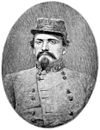
Places Ben Johnson House · John Hunt Morgan Memorial · Ohio Penitentiary · Hunt-Morgan House · Alice Dean · Corydon Historic District · Stream Cliff Farm · John Hunt Morgan Heritage Trail · Battle of Tebb's Bend Monument · Midway Historic DistrictBattles/Raids Historic district Corydon Historic District

Other properties U.S. National Register of Historic Places Topics Lists by states Alabama • Alaska • Arizona • Arkansas • California • Colorado • Connecticut • Delaware • Florida • Georgia • Hawaii • Idaho • Illinois • Indiana • Iowa • Kansas • Kentucky • Louisiana • Maine • Maryland • Massachusetts • Michigan • Minnesota • Mississippi • Missouri • Montana • Nebraska • Nevada • New Hampshire • New Jersey • New Mexico • New York • North Carolina • North Dakota • Ohio • Oklahoma • Oregon • Pennsylvania • Rhode Island • South Carolina • South Dakota • Tennessee • Texas • Utah • Vermont • Virginia • Washington • West Virginia • Wisconsin • WyomingLists by territories Lists by associated states Other Categories:- Historic districts in Indiana
- Corydon, Indiana
- National Register of Historic Places in Harrison County, Indiana
- Federal architecture in Indiana
- Open air museums in Indiana
- Historic house museums in Indiana
- Museums in Harrison County, Indiana
- Indiana State Historic Sites
- Visitor attractions in Harrison County, Indiana
- Buildings and structures in Harrison County, Indiana
Wikimedia Foundation. 2010.

